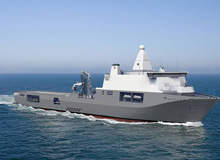
Karel Doorman is a joint logistic support ship designed and built by Damen Schelde Naval Shipbuilding (DSNS) for the Royal Netherlands Navy. The vessel can be used for multiple naval support missions.
The new logistical support vessel is the biggest ship in the Royal Netherlands Navy and is developed to replace the HNLMS Zuiderkruis supply ship, which was decommissioned in 2012, and the HNLMS Amsterdam, which was decommissioned in December 2014.
The Karel Doorman joint logistic support ship can be deployed to provide strategic sea and logistics support from the sea (seabasing), as well as resupply maritime units at sea. It can also perform helicopter operations, training, humanitarian aid and disaster relief, and repair and maintenance support missions.
The ship was officially named and commissioned in March 2014. It was officially delivered by the Netherlands Defence Material Organisation (DMO) to the Royal Netherlands Navy in September 2015.
Karel Doorman construction
The Netherlands’ DMO awarded a contract to DSNS for the construction of the Karel Doorman joint logistic support ship in December 2009.
The keel for the vessel was laid down at the Damen shipyard in Galati, Romania, in June 2011. The ship was launched in October 2012 and shifted to the Vlissingen shipyard for final systems outfitting and commissioning in July 2013.
The IP Company installed a highly advanced communication system, as well as a wireless communication and messaging system (WCMS), in the vessel in August 2013. The system facilitates communication among the crew and provides current status of the vessel. Installation of the integrated sensor and communication suite (GSCS), developed by Thales Nederland, began in January 2014.
The vessel performed platform sea trials in May 2014 and was transferred from DSNS to DMO in July 2014.
Karel Doorman design, features and capacities
The new Karel Doorman joint logistics support vessel incorporates a highly flexible design with blast resistant structures. It is fitted with noise and magnetic signature reduction measures.
The vessel has an overall length of 204.7m, width of 30.4m, height of 53m, and draft of 7.8m. The weight of the empty vessel is 17,200t and the maximum full load displacement is approximately 27,800t. It can carry 175 crew and 125 specialist personnel. It can also accommodate two operating theatres and a quarantine complex.
The vessel features a large helicopter flight deck to facilitate take-off and landing of two Chinook helicopters with fully spread blades or six medium weight helicopters with folded blades.
The vessel is also equipped with two davit-launched landing craft vehicle personnel (LCVP) units. It can carry a 2,350m² roll-on roll-off cargo deck, 7,700m³ of fuel, 400m³ of freshwater and 1,000m³ of helicopter fuel. It is capable of transporting 5,000t of heavy rolling armoured materiel using a crane and lift.
Sensor and communications suite of Karel Doorman ship
The Karel Doorman ship is equipped with a Link 11 digital data communication network to provide point-to-point data communication, identification, and friend or foe (IFF) system for command and control exercises. It also features extensive radar systems to provide surveillance for surface-to-surface and ground-to-air operations.
The sensor and communication mast also includes a secure local area network (LAN), an internal communication system, satellite communications (SATCOM) system, LF/MF/HF/VHF/UHF transceivers, IO-detection system, global maritime distress and safety system (GMDSS), and joint maritime command information system (JMCIS).
Armament and protection
Karel Doorman is equipped with two Goalkeeper autonomous, automatic close-in weapon systems (CIWS) to defend missiles, aircraft and surface ships. The CIWS can fire at a rate of 4,200 rounds a minute.
The ship is also armed with four Super Rapid Bloom Off-board Countermeasures (SRBOC) launchers, two 30mm remote-controlled force protection guns, and four .50 medium calibre remote-controlled guns.
Protection equipment includes ballistic protection systems, shock-resistant systems, firefighting systems, degaussing systems and a gas citadel.
Karel Doorman ship propulsion and performance
The Karel Doorman vessel is powered by a diesel electric propulsion system consisting of five diesel generators with a power output of approximately 24.8MW. The propulsion system also consists of two fixed pitch propellers and rudders, two 1.25MW bow thrusters, and a 0.75MW stern thruster.
The joint logistic support ship can sail at a speed of 18k and has a range of 10,000nmi at a speed of 15k.



